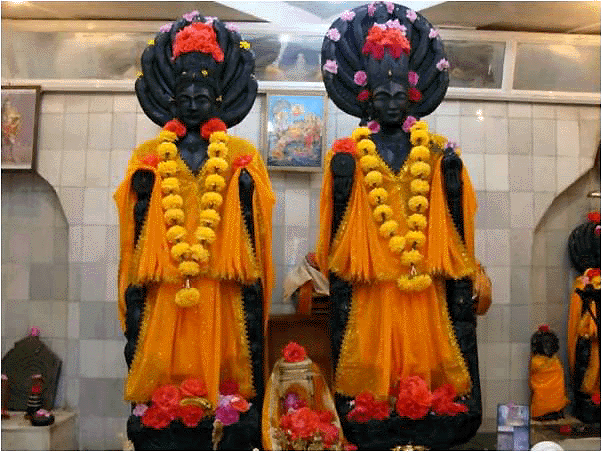The Curse of Kadru
BY: SUN STAFF
Feb 11, 2013 — CANADA (SUN) — Kadru, the daughter of Daksha and the wife of Kashyapa, is described in the Vedas as being the ancestral mother of the Nagas (snakes). In the Varaha Purana, the sage Mahatapa explains that the line of the Nagas originated with Kadru, with along with Kashyapa had numerous progeny, most notably Vasuki, Anant, Kambal, Karkotak, Padma, Mahapadma, Shankh, and Kulik, among others. When the Nagas began tormenting the human beings, Lord Brahma cursed them with annihilation during the Swayambhuva manvantar, due to the curse of their own mother, Kadru.
The serpents became terrified and promised to remediate their offensive activities. Begging Lord Brahma to give them a place to live in, he instructed them to go to three different netherworlds: Sutal, Vital and Patal. He also warned them that during Vaivaswat manvantar, Janamejaya would perform a grand yagya with the objective of destroying all of the demoniac among them, with only the virtuous Nagas surviving. The yajya of Janmejay took place on Panchami, which became known as the destroyer of all sins. Devotee who worship the Nagas offer them milk on this day.

Kashyap Rishi's Queens, Kadru and Vanita
Vasuki Naga Temple, Kashmir
Kadru's Wager
Kadru once made a wager with her sister Vinata, the stakes being that the loser would be enslaved to the winner. Eager to secure victory, Kadru attempted to fix the bet by requesting the cooperation of her Naga offspring. When her children balked at the request, Kadru grew angry and fulfilling the curse of Lord Brahma, she cursed her progeny to die a fiery death in the snake-sacrifice of King Janamejaya.
King Janamejaya was the son of Pariksit, who was Abhimanyu's son. Abhimanyu was the son of Arjuna and Subhadra, and Sri Krishna's nephew. Since Arjuna was Yudhisthira's brother, Janamejaya was also the great-grandson of Yudhisthira.
Being aware of the curse made against them by mother Kadru, Vasuki, the king of the snakes, understood that his brethren would need protection. He therefore approached the renowned ascetic Jaratkaru with a proposal of marriage to the snake-goddess, Manasa, Vasuki's own sister. Out of this union of Jaratkaru and Manasa was born Astika, known as "a son of the splendor of a celestial child," and it was he who became the savior of the Nagas.
In the Twelfth Chapter, Second Skandha of the Srimad Devi Bhagavatam is described the pastime of the birth of Astika, protector of the Nagas. The Devi Bhagavatam is one of the Upapuranas, being comprised of 18,000 verses from Veda Vyasa glorifying the Devi (goddess).
In accordance with Kadru's curse, Janamejaya prepared a snake sacrifice, which is described in the Puranas. He erected a sacrificial platform and hired brahmans and others trained to conduct the yajnic rites. Following the proper form, the priests lit the sacrificial fire, duly fed it with clarified butter. Uttering the required mantras, they began calling the names of Nagas. The potency of the rite was such that the Nagas were summoned by name into the fire, in which they were mortally consumed.
As the sacrifice continued and countless Nagas lost their lives to the fire, Astika came to the rescue less the entire race be lost. He approached Janamejaya and praised the sacrifice in such eloquent terms that the King offered to grant him a boon of his choosing. Astika promptly requested that the sacrifice be terminated. Though initially regretful of his offer, Janamejaya was true to his word, and thus brought the sacrifice of the Nagas to an end.
The Revenge of Janamejaya on the Nagas
The Mahabharata further describes the reasons for King Janamejaya's inclination to take revenge on the Nagas. Janamejaya ascended to the throne of Hastinapura upon the death of his father, King Pariksit, the lone descendant of the House of Pandu. King Pariksit had died of snakebite due to a curse by a sage, which was consummated by the Naga leader, Takshak. Consequently, Janamejaya held a deep grudge against the serpents for this act, and was intent on wiping them out altogether.
Just as Janamejaya was about to begin the Sarpa satra sacrifice, Vyasa arrived with a host of other rishis. The sages told Janamejaya that to avenge himself on all Nagas, for the action of one, who was after all consummating a curse, would be unrighteous and an act not worthy of one descended from the Pandavas themselves. To satisfy Janamejaya's wish to know more about the pastimes of his forefathers, Vyasa's disciple Vaishampayana narrated the Mahabharata, right at the spot where the homa was to be held.
The fire yajna was started on the banks of the River Arind at Bardan, now known as Parham (a corrupted form of 'Parikshitgarh'). A masonry tank said to have been built by King Janamejaya to mark the site of the sacrificial pit, known as Pariksit Kund, still exists there in Mainpuri district. Close to the village are the ruins of a fort and other artifacts which date back to the time of Emperor Pariksit.
